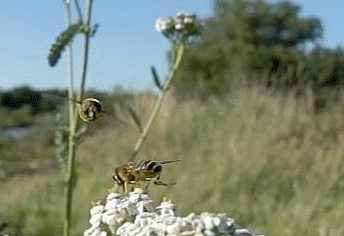| Eristalis nemorum | |
|---|---|

| |
| female | |
| Scientific classification | |
| Kingdom: | |
| Phylum: | |
| Class: | |
| Order: | |
| Family: | |
| Genus: | |
| Subgenus: | Eoseristalis
|
| Species: | E. nemorum
|
| Binomial name | |
| Eristalis nemorum | |
| Synonyms | |
Eristalis nemorum is a species of hoverfly. It is found in the Palearctic (Fennoscandia South to Iberia, the Balkans and Italy, Ireland eastwards through Central Europe into Turkey and Russia and on into the Russian Far East, Siberia and Japan) and in the Nearctic (Quebec south to Colorado).[2][3] [4]
YouTube Encyclopedic
-
1/1Views:334
-
Drone Fly - Eristalis interruptus - Blómaflugur - Fluga - Skordýr - Matlaukur - Hvít blóm
Transcription
Technical description
External images For terms, see: Morphology of Diptera.
Wing length: 8.25–10.5 mm (0.325–0.413 in). All tarsi are extensively black. Body-hairs are short. Arista plumose basal half. Densely dusted face has a black shining stripe. Hind femora are black in male. Wings are hyaline with quadrate brownish pterostigma (basal to merge of vein sc with costa). Body is yellow-haired. Hind metatarsi are darkened.[5][6][7][8] The male genitalia are figured by Hippa et al. (2001).[9] The larva is figured by Hartley (1961).[10]
Biology
The larvae are aquatic, and of the Rat-tailed maggot type. Adults are often seen visiting flowers. Flight period in the United Kingdom is from April to October, peaking around July and August. The males show a characteristic courtship display, hovering above a foraging female for minutes.[11]

When many males are present two or more males may hover above one female.

Adult habitat is streamsides, fen meadow and poorly-drained pasture. Flowers visited include yellow composites, umbellifers, Cakile, Calluna vulgaris, Caltha, Cardamine, Cirsium, Crataegus, Eupatorium, Euphorbia, Filipendula, Malus, Menyanthes, Mentha, Parnassia, Prunus, Ranunculus, Rubus fruticosus, Salix, Sorbus, Succisa.[12]
References
- ^ Stubbs, Alan E.; Falk, Steven J. (1983). British Hoverflies: An Illustrated Identification Guide. British Entomological & Natural History Society. pp. 253, xvpp.
- ^ "Fauna Europaea". Archived from the original on 2018-08-30. Retrieved 2017-01-17.
- ^ Peck, L.V. (1988) Syrphidae. In: Soos, A. & Papp, L. (eds.) Catalogue of Palaearctic Diptera, 8: 11–230. Akad. Kiado, Budapest.
- ^ Speight, M.C.D. (2011). "Species accounts of European Syrphidae (Diptera)" (PDF). Syrph the Net, the Database of European Syrphidae. 65: 285pp.
- ^ Van Veen, M. (2004). Hoverflies of Northwest Europe: identification keys to the Syrphidae. 256pp. KNNV Publishing, Utrecht.addendum
- ^ Van der Goot, V.S. (1981). De zweefvliegen van Noordwest-Europa en Europees Rusland, in het bijzonder van de Benelux. KNNV, Uitgave no. 32: 275pp. Amsterdam.
- ^ Bei-Bienko, G.Y. & Steyskal, G.C. (1988). Keys to the Insects of the European Part of the USSR, Volume V: Diptera and Siphonaptera, Part I. Amerind Publishing Co., New Delhi. ISBN 81-205-0080-6.
- ^ Coe, R.L. (1953). "Diptera: Syrphidae". Handbks.ident.Br.insects, 10(1): 1-98. R. ent. Soc. London. pdf Archived 2018-10-04 at the Wayback Machine
- ^ Hippa, H., Nielsen, T.R. & van Steenis, J. (2001) The west Palaearctic species of the genus Eristalis Latreille (Diptera, Surphidae). Norw. J. Entomol. 48: 289–327.
- ^ Hartley, J.C. (1961) A taxonomic account of the larvae of some British Syrphidae. Proc. Zool. Soc. Lond. 136: 505–573.
- ^ Wijngaard W (2010). "Accuracy of insect position control as revealed by hovering male". Eristalis nemorum. Proc. Neth. Entomol. Soc. Meet. 21. pp. 75–84.[1] Archived 2017-02-23 at the Wayback Machine
- ^ de Buck, N. (1990). "Bloembezoek en bestuivingsecologie van Zweefvliegen (Diptera, Syrphidae) in het bijzonder voor België". Doc.Trav. IRSNB, no. 60, pp. 1–167.
